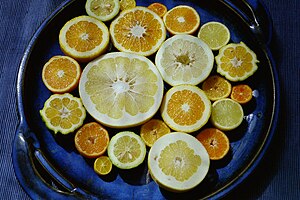
The botanical classification of the species, hybrids, varieties and cultivars belonging to the genus Citrus is called "citrus taxonomy".
Citrus taxonomy refers to the botanical classification of the species, varieties, cultivars, and graft hybrids within the genus Citrus and related genera, found in cultivation and in the wild.
Citrus taxonomy is complex and controversial.[1][2] Cultivated citrus are derived from various citrus species found in the wild. Some are only selections of the original wild types, many others are hybrids between two or more original species, and some are backcrossed hybrids between a hybrid and one of the hybrid's parent species. Citrus plants hybridize easily between species with completely different morphologies, and similar-looking citrus fruits may have quite different ancestries.[3][4] Some differ only in disease resistance.[5] Conversely, different-looking varieties may be nearly genetically identical, and differ only by a bud mutation.[6]
Detailed genomic analysis of wild and domesticated citrus cultivars has suggested that the progenitor of modern citrus species expanded out of the Himalayan foothills in a rapid radiation that has produced at least 11 wild species in South and East Asia and Australia, with more than a half-dozen additional candidates for which either insufficient characterization prevents definitive species designation, or there is a lack of consensus for their placement within the Citrus genus rather than sister genera. Most commercial cultivars are the product of hybridization among these wild species, with most coming from crosses involving citrons, mandarins and pomelos.[7][8] Many different phylogenies for the non-hybrid citrus have been proposed,[9] and the phylogeny based on their nuclear genome does not match that derived from their chloroplast DNA, probably a consequence of the rapid initial divergence.[7] Taxonomic terminology is not yet settled.
Most hybrids express different ancestral traits when planted from seeds (F2 hybrids) and can continue a stable lineage only through vegetative propagation. Some hybrids do reproduce true to type via nucellar seeds in a process called apomixis.[4] As such, many hybrid species represent the clonal progeny of a single original F1 cross, though others combine fruit with similar characteristics that have arisen from distinct crosses.
- ^ Moore, G. A. (Sep 2001). "Oranges and lemons: clues to the taxonomy of Citrus from molecular markers". Trends in Genetics. 17 (9): 536–540. doi:10.1016/s0168-9525(01)02442-8. PMID 11525837.
- ^ Luro, François; Curk, Franck; Froelicher, Yann; Ollitrault, Patrick (2018-01-15), Fiorentino, Girolamo; Zech-Matterne, Véronique (eds.), "Recent insights on Citrus diversity and phylogeny", AGRUMED: Archaeology and history of citrus fruit in the Mediterranean : Acclimatization, diversifications, uses, Collection du Centre Jean Bérard, Naples: Publications du Centre Jean Bérard, doi:10.4000/books.pcjb.2169, ISBN 978-2-918887-77-5, retrieved 2021-10-19
- ^ Velasco, Riccardo; Licciardello, Concetta (2014). "A genealogy of the citrus family". Nature Biotechnology. 32 (7): 640–642. doi:10.1038/nbt.2954. PMID 25004231. S2CID 9357494.
- ^ a b Wu, G. Albert; et al. (2014). "Sequencing of diverse mandarin, pomelo and orange genomes reveals complex history of admixture during citrus domestication". Nature Biotechnology. 32 (7): 656–662. doi:10.1038/nbt.2906. PMC 4113729. PMID 24908277.
- ^ Li, Xiaomeng; Xie, Rangjin; Lu, Zhenhua; Zhou, Zhiqin (2010). "The Origin of Cultivated Citrus as Inferred from Internal Transcribed Spacer and Chloroplast DNA Sequence and Amplified Fragment Length Polymorphism Fingerprints". Journal of the American Society for Horticultural Science. 135 (4): 341–350. doi:10.21273/JASHS.135.4.341.
- ^ Nicolosi, Elisabetta; La Malfi, Stefano; El-Otmani, Mohamed; Neghi, Moshe; Goldschmidt, Eliezer E (2005). "The Search for the Authentic Citron (Citrus medicus L.): Historic and Genetic Analysis". HortScience. 40 (7): 1963–1968. doi:10.21273/HORTSCI.40.7.1963.
- ^ a b Wu, Guohong Albert; Terol, Javier; Ibanez, Victoria; et al. (2018). "Genomics of the origin and evolution of Citrus". Nature. 554 (7692): 311–316. Bibcode:2018Natur.554..311W. doi:10.1038/nature25447. PMID 29414943. and Supplement
- ^ Wu, Guohong Albert; Sugimoto, Chikatoshi; Kinjo, Hideyasu; et al. (2021). "Diversification of mandarin citrus by hybrid speciation and apomixis". Nature Communications. 12 (1): 4377. Bibcode:2021NatCo..12.4377W. doi:10.1038/s41467-021-24653-0. PMC 8313541. PMID 34312382. and Supplement
- ^ García Lor, Andrés (2013). Organización de la diversidad genética de los cítricos (PDF) (Thesis). p. 79.(in Spanish)
© MMXXIII Rich X Search. We shall prevail. All rights reserved. Rich X Search
